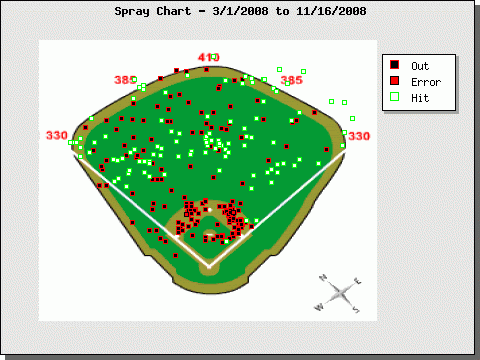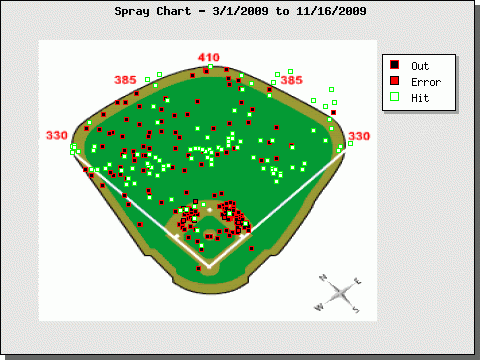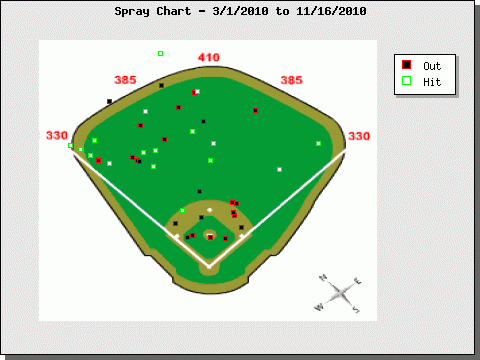Adam Jones’ Regression At The Plate
I don’t think it’d be a stretch to say that Adam Jones has been a big disappointment at the plate so far in 2010. He came into Saturday’s game batting just .254/.283/.384, and instead of taking a step forward from his .277/.335/.457 line in 2009 he’s taken a step (or two) back. What might be going on?
It’s not exactly news to say that Adam’s not the most disciplined hitter, but that’s actually gotten worse this year:
| Year | Swing % | O-Swing % | Z-Swing % | In Zone Swing % |
| 2008 | 53.5% | 36.2% | 69.1% | 68.0% |
| 2009 | 53.7% | 35.3% | 73.2% | 66.0% |
| 2010 | 52.5% | 40.1% | 65.2% | 61.3% |
Jones is swinging about as often he has in recent years, though that’s still a much higher mark than your average batter. He is chasing pitches out of the strike-zone more than he used to, and even the mid 30s rates were high. He started out last season getting that rate down a little, but his slump coincided in part with starting to chase balls close to that 40% rate he’s continued into this season. Adam’s swing at strikes less though, which means the percent of pitches that he swings at that are better to hit – in the zone (the last column) – has gone down. For the average batter, somewhere around 70% of the pitches they swing at are in the strike-zone. For Jones this year, that’s down to just 61%. So even if he’s going to be making contact – which he isn’t exactly great at anyway – it’s not going to be on as good of a pitch to hit.
Now, one might think that Jones is chasing more balls because pitches are throwing him a bunch of sliders and curveballs out of the zone. I think we all have that mental image of Adam waving at a slider down and away. That’s not exactly the case though:
| Year | Fastball% | Change-up% | Slider% | Curveball% |
| 2008 | 58.5% | 7.6% | 18.8% | 12.7% |
| 2009 | 62.3% | 9.9% | 17.6% | 10.1% |
| 2010 | 63.1% | 10.1% | 13.5% | 8.0% |
In his first full season pitchers tried to get him to chase, but now they seem to be challenging him more. I don’t think that’s a good sign. How often does he swing at each pitch?
| Year | Fastball S% | Change-up S% | Slider S% | Curveball S% |
| 2008 | 51.0% | 62.0% | 57.9% | 48.5% |
| 2009 | 52.0% | 57.4% | 59.9% | 50.5% |
| 2010 | 51.5% | 52.2% | 60.7% | 45.6% |
Very consistent on the heaters each season. He’s taking more change-ups and – in 2010 at least – curveballs as well. That slider continues to be his nemesis, as even though he’s seeing fewer of them he is swinging more often at the ones he does see. The percent of total pitches that Adam has thrown to him that fall into the “swinging at a slider” group has fallen though, from over 10% in ‘08 and ‘09 to about 7.4% in ‘10. Even when you add in the fact that his contact rate against the pitch has gotten worse, the percent of all pitches that end up as sliders that have been swung on and missed has gone down.
Breaking out the pitch types by in the zone versus out of the zone was inexact, but it looks like a much higher percentage of the fastballs thrown to Jones are in the strike-zone while a much lower percent of sliders and (especially) change-ups.
So summarizing the best I can by pitch type:
Fastball: Seeing more of them, principally in the strike-zone; swinging at them as much as he used to, and also making contact more often when he swings.
Change-up: Seeing more of them, and more of them out of the zone; swinging at them less, but making less contact when he does swing.
Slider: Seeing a lot less of them, but more frequently out of the zone; still chasing a lot, with slightly higher whiff rate.
Curveball: Seeing less of them, with about the same frequency in the zone; chasing it less, and still whiffing a whole lot on it.
It looks to me like Adam is taking pitches early in the count a little more often – getting fastballs in the zone to fall behind (he went to an 0-1 count over 55% of the time, and was getting a first-pitch fastball much more often – almost 70% of the time – which explains more than the entire increase in fastball usage overall) – and then chasing pitches out of the zone later in the count. He’s maybe trying to work the count, but doesn’t have the pitch recognition or the ability to tell a ball from a strike that’s needed to carry through on it.
Jones is striking out more and walking much less this year, and given his swing rates, those marks (~3% and ~21% respectively) aren’t out of line. If that doesn’t change – especially the first number – then it’s going to be very hard for him to be even an average hitter. ZiPS still thinks it’ll get better though, projecting a line from here to the rest of the season of .273/.327/.461. I don’t want to overreact to 40 games, but it certainly is concerning (and swing rates are the first things to stabilize). Also – it should be noted – it wouldn’t matter so much if Jones was playing plus defense in center.
Article originally posted at Camden Crazies.



